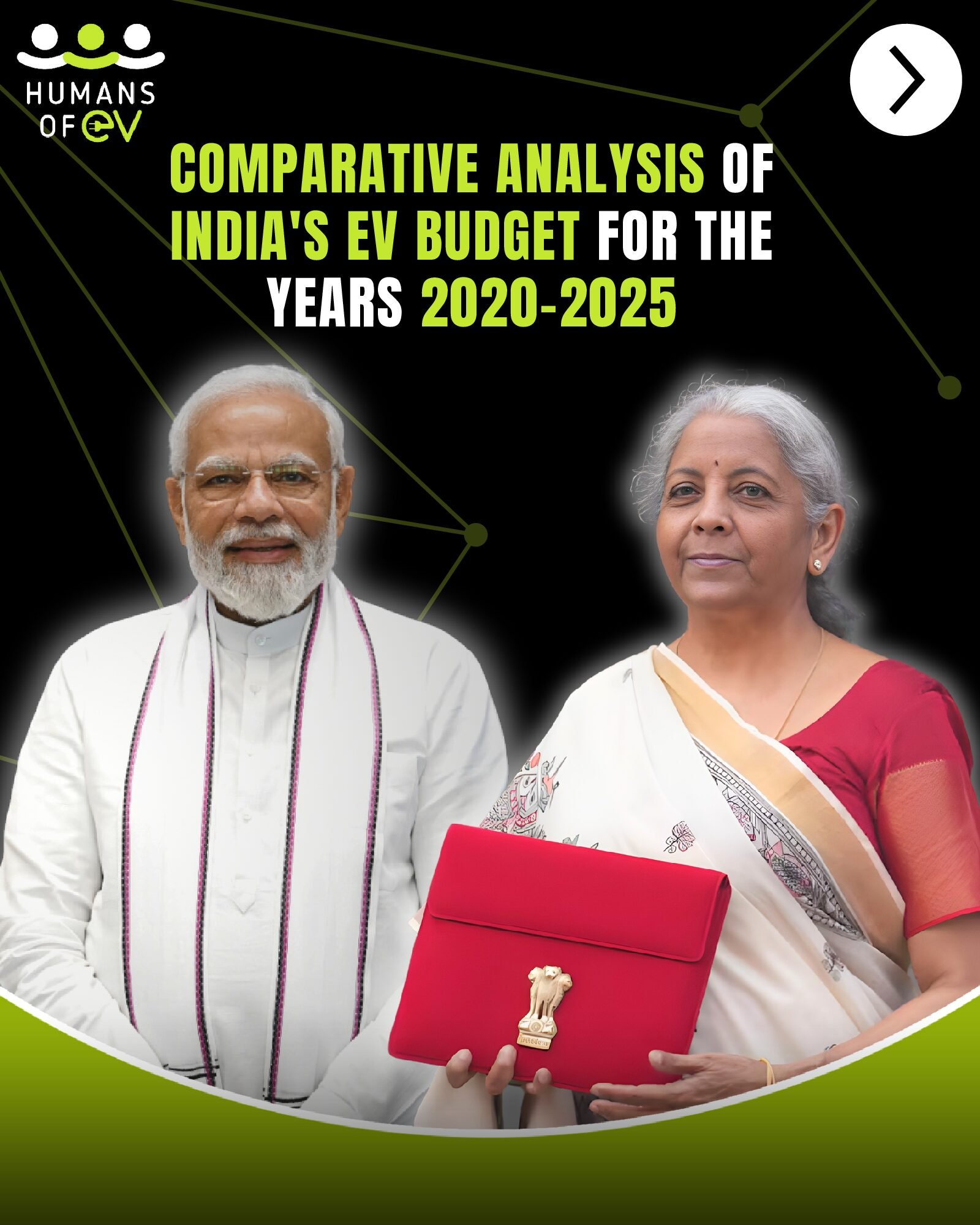
February 3rd, 2025
The electric vehicle (EV) industry in India has witnessed remarkable policy shifts over the last five years. With each budget, the government has refined its strategy, moving from direct subsidies to long-term sustainability measures. This article provides a deep analysis of the budgets from 2020 to 2025, highlighting key policies, incentives, and their impact on consumers and the industry.
Key EV Policies Over the Years
2020: Laying the Foundation for EV Growth
- Taxation: GST on EVs was reduced to 5% (compared to 28% for ICE vehicles), making EVs more affordable.
- Subsidies: ₹10,000 crore allocated for the FAME-II scheme to boost EV adoption.
- Infrastructure: Minimal budget allocation for charging stations.
- R&D and Manufacturing: Introduction of the National Mission on Transformative Mobility and Battery Storage; import duties on lithium-ion cells increased to encourage domestic production.
- Public Transport: Pilot projects for EV adoption in urban mobility.
2021: Strengthening Domestic Manufacturing
- Taxation: No major changes but customs duty exemptions on EV parts continued.
- Subsidies: FAME-II extended, increasing incentives for two- and three-wheelers.
- Infrastructure: ₹1,000 crore allocated for charging stations.
- R&D and Manufacturing: Introduction of the PLI scheme with ₹18,100 crore for battery manufacturing.
- Public Transport: States encouraged to procure e-buses via public-private partnerships.
2022: Focus on Battery Swapping and R&D
- Taxation: Reduction in custom duties on specific EV components.
- Subsidies: Special incentives for battery swapping introduced.
- Infrastructure: Increased investments in urban and highway charging stations.
- R&D: 100% FDI permitted in battery swapping startups.
- Public Transport: Electrification of metro rail services prioritized.
2023: Localization and Rural EV Expansion
- Taxation: Lower GST rates continued, incentives introduced for EV leasing.
- Subsidies: 50% increase in FAME-II subsidy allocation.
- Infrastructure: EV charging stations mandated in commercial complexes.
- R&D and Manufacturing: ₹3,500 crore allocated under the PLI scheme.
- Public Transport: Expansion of e-buses in Tier-2 and Tier-3 cities.
2024: Preparing for a Sustainable EV Ecosystem
- Taxation: Reduced import duties on EV components.
- Subsidies: Introduction of the PM E-DRIVE scheme with ₹10,900 crore allocation.
- Infrastructure: Integration of charging stations with renewable energy sources.
- R&D: ₹1,500 crore allocated for indigenous battery technology.
- Public Transport: Encouragement for metro rail projects to integrate EVs in feeder services.
2025: Shift Towards Self-Sustaining Growth
- Taxation: Customs duties waived on 35 capital goods essential for EV battery production.
- Subsidies: Reduction in direct subsidies but increased tax incentives for manufacturers.
- Infrastructure: Focus on Tier-2 and Tier-3 cities for charging station development.
- R&D: Government incentives for AI-driven autonomous EV technology and solid-state battery research.
- Public Transport: Greater EV adoption in state-run transport corporations.
Comparative Table of EV Budgets (2020-2025)
| Year | Taxation Policies | Subsidies & Incentives | Infrastructure | R&D & Manufacturing | Public Transport |
| 2020 | GST reduced to 5% | ₹10,000 crore for FAME-II | Minimal allocation | National Mission on Transformative Mobility | Pilot EV projects in cities |
| 2021 | No major tax changes | FAME-II extended; increased 2W & 3W incentives | ₹1,000 crore for charging stations | PLI scheme for battery manufacturing | State-level e-bus procurement encouraged |
| 2022 | Custom duty reduction on EV parts | Incentives for battery swapping | Urban & highway charging station focus | 100% FDI for battery startups | Metro rail electrification prioritized |
| 2023 | Continued lower GST, EV leasing incentives | 50% FAME-II subsidy increase | Charging stations mandated in commercial complexes | ₹3,500 crore allocated for PLI | E-buses expanded in Tier-2 & Tier-3 cities |
| 2024 | Reduced import duties on EV components | PM E-DRIVE scheme launched with ₹10,900 crore | Charging stations integrated with renewable energy | ₹1,500 crore for battery R&D | Metro projects encouraged to integrate EVs |
| 2025 | Waived duties on 35 key EV battery goods | Direct subsidies reduced; tax incentives increased | Tier-2 & Tier-3 city focus | AI-driven EV & solid-state battery R&D | Increased EV adoption in state transport |
Evolution of Taxation Policies
GST on EVs and Components
- 2020: Slashed to 5% to make EVs more competitive.
- 2021-2024: Maintained at 5% to ensure affordability.
- 2025: No changes, indicating a stable policy approach.
Customs Duties on Imports
- 2020: High import duties on completely built units (CBUs) to promote local assembly.
- 2021-2023: Select reductions in duties to support domestic production.
- 2024: Full exemption on 25 critical minerals for battery production.
- 2025: Further waivers on 35 essential EV battery production goods.
Income Tax Benefits
- 2020-2024: No major exemptions for EV buyers.
- 2025: Tax exemption limits raised to ₹12 lakh, indirectly boosting EV demand.
Conclusion: A Transition Towards Sustainability
India’s EV budget over the years reflects a well-calibrated approach, shifting from heavy subsidies to long-term sustainability and industry-driven growth. While the early years focused on incentives and affordability, recent budgets prioritize infrastructure, local manufacturing, and research. The 2025 budget signals a move towards self-sustaining industry growth, paving the way for India’s transition to a fully electric future.
With improved infrastructure, continued policy support, and rising consumer demand, India is well on its way to becoming a global EV powerhouse.



